Ever wondered why that discounted price seems so irresistible? It’s not just the savings—it’s the power of price anchoring.
This psychological principle, widely used in sales and marketing, leverages our tendency to judge value based on comparison. By setting an initial reference point (the “anchor”), businesses can make a product’s price seem more attractive than it would on its own.
Whether it’s a high-low pricing strategy, premium product positioning, or simply showing a competitor’s higher price, price anchoring subtly nudges us toward a purchase.
This guide will explore the mechanics and real-world examples of price anchoring.
Price Anchoring Definition
Price anchoring is a psychological principle describing how people use a reference point to judge the value of something, especially its price.
This initial information acts as an “anchor,” influencing subsequent judgments. For example, if a product is initially presented at a high price and then discounted, the discounted price seems more appealing because it’s compared to the higher anchor.
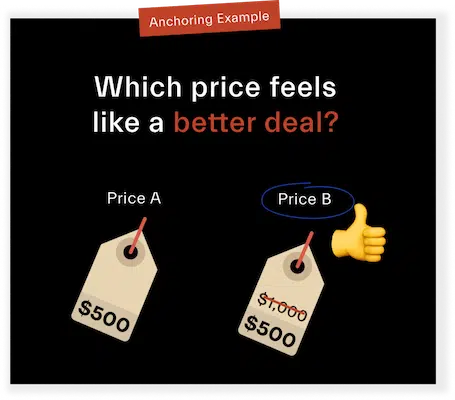
Here’s how prince anchoring works in principle:
- Relative Perception: Consumers perceive a product’s value based on its relationship to the anchor price. A $50 product may seem expensive on its own, but it would be a bargain if it was initially $90.
- Cognitive Bias: The brain uses mental shortcuts to process information quickly. Price anchoring takes advantage of this by making the initial price the primary reference point.
Price anchoring isn’t just a theoretical concept—it’s a practical tool businesses use daily to optimize their conversion rates and transform their sales and marketing campaigns.
By strategically setting anchor prices, companies can subtly guide consumer perception and encourage purchases they might not have otherwise made.
So, how do businesses leverage this psychological phenomenon to boost their sales? Here are the three most common price anchoring tactics:
- High-Low Pricing: This common tactic involves setting a high initial price (the anchor) and offering discounts or promotions. The discounted price is more attractive.
- Premium Pricing: Positioning a product or service at a higher price point creates an anchor that makes other offerings seem more reasonable.
- Comparative Pricing: Showing a competitor’s higher price alongside your own makes your product seem like a better deal.

Examples Of Price Anchoring.
Let’s take a closer look at how several successful e-commerce brands leverage price anchoring to drive subscriptions and sales.
How NatureBox, Harry’s, and Four Sigmatic Leverage Price Anchoring To Get More Subscribers
NatureBox, a healthy snack subscription service, cleverly utilizes price anchoring to make its membership more enticing.
They prominently advertise “$60 in credits annually,” framing it as an unexpected gift.

This sizeable annual figure is an anchor, making the actual $5 per month seem trivial.
By focusing on the perceived value of the annual credit, NatureBox downplays the recurring monthly expense, making the membership a more appealing prospect.
Harry’s: Anchoring Annual Costs to Monthly Prices
Now, let’s talk about Harry’s. This DTC brand sells razors, blades, skincare, and hair care products for men. They’re successful, with revenue between $300M and $400M/year. On top of that, they even got $345M in funding.
Most of this success comes from the ability to build a stable, repeatable business, leveraging memberships and subscriptions.
If we go to their pricing page, we see that they leverage the price anchoring bias to lower the annual membership cost.

$15/year may already seem too much for their target audience, but that doesn’t happen if we attach the price to a smaller time frame, like months.
I’d also suggest using only a monthly anchor because once it is set, people won’t bother too much about paying $15/year: their brain has already been primed by the monthly cost, so they’ll convince themselves during the buying process.
Key takeaways for your business:
- Frame Membership Costs: When presenting subscription pricing, anchor the cost to a smaller timeframe (e.g., monthly) to make it seem more affordable.
- Highlight Annual Benefits: If your membership offers credits or rewards, present them annually to emphasize their value and create a sense of generosity.
How Mindlabpro And Four Sigmatic Leverage Price Anchoring To Sell More Items
Four Sigmatic, aware of the power of price anchoring, uses daily time frame anchors on its membership page to make its products seem more affordable.
In fact, on their membership page, they use anchors attached to a daily time frame for both of the products displayed.
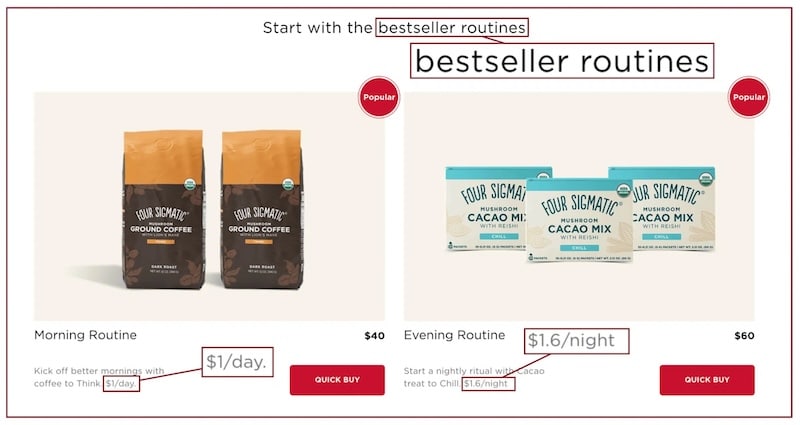
Nevertheless, I’d set this up differently.
They don’t currently leverage the full power of the priming and price anchoring effects since it’s easier for people to look at the total price.
I’d expect a slight increase in demand if we switched those two prices, but that’s something they can test.
Mindlabpro, a product I use daily, leverages the price anchoring effect to increase their Average Order Value by up to 50%.
How’s that happening? Because they leverage the price anchoring effect.
They’ve chosen a custom anchor bound to its serving size, which is common in the supplements industry.
What’s not expected is their offering. They leverage the most significant package, which includes one free bottle, to lower the price of a bottle and the standard serving by 25%, compared to the 2-month supply option.
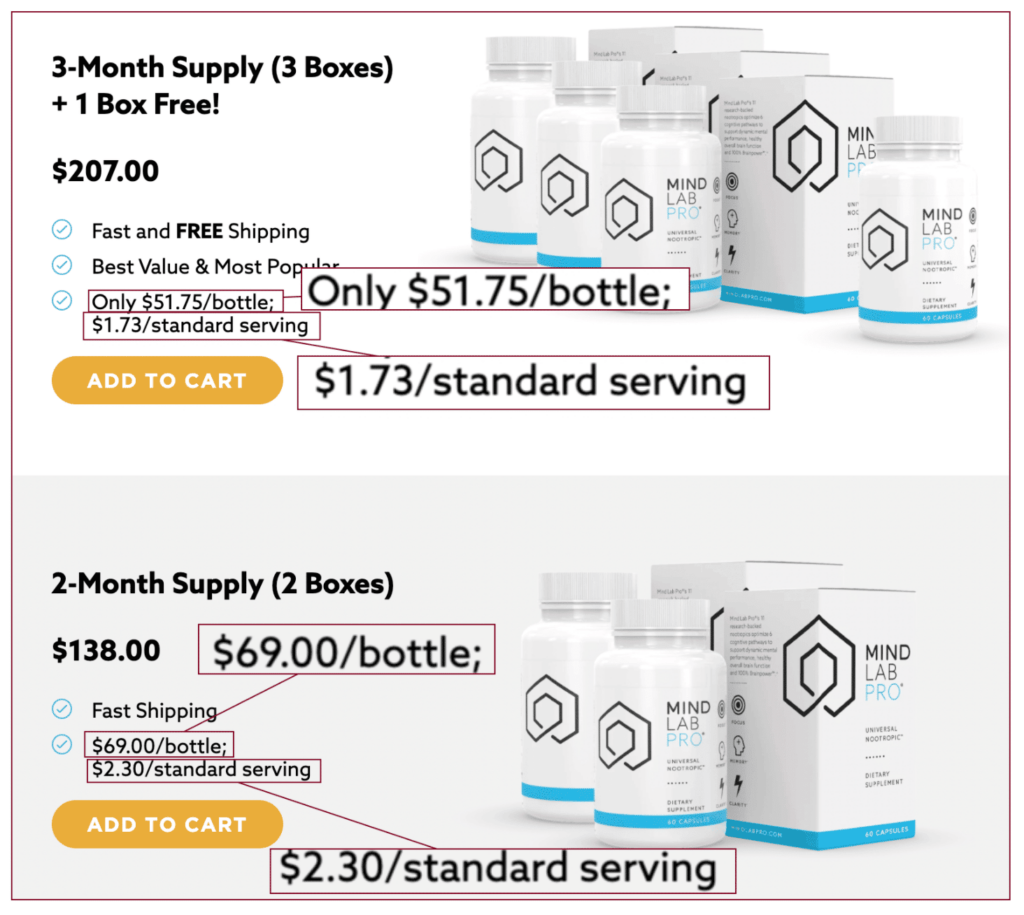
Here’s your key takeaway for this section:
- When you want to lower your perceived price, choose a custom anchor, like the serving size for Mindlab Pro and day/night for Four Sigmatic.
How Casper Leverages The Price Anchoring Effect To Sell More $1k+ Mattresses
While offering discounts and financing options is a common way to leverage price anchoring, Casper takes it a step further.
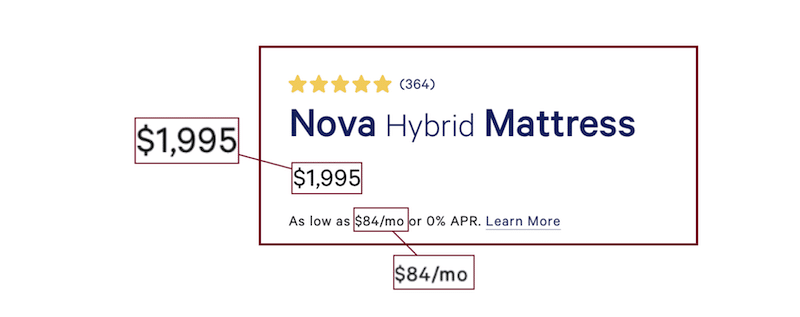
Casper cleverly uses both consumer and color psychology to direct consumer attention.
In the section below, Casper is doing two things:
- They make it easier to read the lower price in green.
- They strike through the higher one, so it’s harder to read.
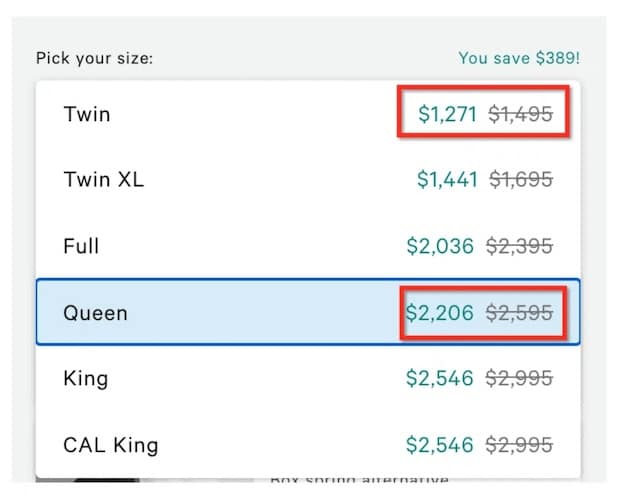
What happens in the customer’s mind here?
First, they notice the lower price and decide it’s high. Then, they read the higher one.
When we use more energy than usual for a given task, our brains think its value is higher. In this case, reading a non-strikethrough, green text is easier than reading a strikethrough, gray text.
Moreover, the green price means reassurance and growth, reinforcing a positive mental association in the customer’s mind for the product’s actual cost.
Following that exact order, people will notice the green price first and then the gray one.
Thanks to this one-two-punch effect, they’ll feel they made a deal for their own bucks since they’ve now associated a higher value with the product.
Here’s your key takeaway from this section:
- Set a monthly anchor like Casper, leveraging installment plans.
- Leverage color and consumer psychology like Casper to lower your product price.
- Choose a custom anchor, like the serving size for Mindlab Pro.
Let’s see how Organifi and Supply leverage the price anchoring to blow away competitors.
How Organifi and Supply leverage the price anchoring effect to win over their competitors
You’re probably aware of the crazy conversion rate Organifi gets for its pages, about 10%. Although I don’t agree with some of their practices to get more subscribers, I have to say their comparison table towards the end of the page is well thought out.

Here, they leverage both the Distinction and Price Anchoring effects.
The Distinction effect views two options as more distinctive when evaluating them simultaneously than when evaluating them separately. People over-examine and over-value the differences between things they are stacking against each other.
In this case, it’s easy to see how Organifi stacks against worse market solutions like Gatorade and Redbull.
However, that’s not all. If you dig further, you’ll see they leverage the price anchoring to let you see how cheaper their product is compared to typical market solutions.
Truthfully, the Red Juice ultimately costs us more than a Red Bull. However, after reading that price, your brain is primed, and you can’t help but think about the low serving price.
Last but not least, I enjoyed learning about how Supply uniquely leverages the Distinction bias and the Price Anchoring bias.
On the other hand, Supply takes a unique approach, leveraging both biases for their non-disposable razors.
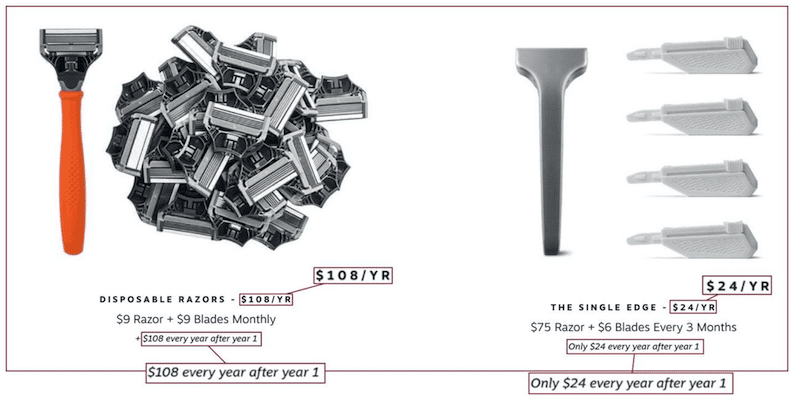
➤ The single edge costs $24/year
➤ Disposable razors cost you $108/year
Truthfully, this is the first price displayed. Going deeper, you’ll learn that:
➤ Razor blades cost you $9 + $9/mo, therefore $108/year
➤ The Single Edge costs you $75 + $6/3mo, therefore $99/year
You may have been confused up to this point, but the last sentence solves your concerns: it states that the first price comes true after the first year of use.
Leveraging these techniques can prime visitors to think of a specific price in the long run, even though your product is more expensive upfront.
Here are key takeaways for your business:
- Disposable products: Use the Distinction and Price Anchoring biases to create your custom anchor against competitors, similar to Organifi.
- Non-disposable products competing against disposables: Lower your product’s perceived long-term price by showing the cost after the first year and addressing potential objections head-on.
Conclusion
That was the last section of this article, and I hope you enjoyed it. This is just one of the over forty psychological principles you can leverage to improve your customer experience and skyrocket your metrics. I’ve been working on the consumer psychology handbook, where I share 100+ examples of more than 40 consumer psychology principles from top brands in multiple industries.
It’s a down-to-earth approach to consumer psychology. I made a to-do checklist for each principle so you can apply it to your website. The book will launch later, but you can get the first chapter by emailing me using this link.
Price Anchoring FAQs
1. What is price anchoring?
Price anchoring is a psychological strategy where an initial price (the “anchor”) influences a consumer’s perception of the value of a product or service. It makes the price of an item seem more favorable compared to the anchor.
2. When is price anchoring used?
Price anchoring is used in various scenarios to influence consumer perceptions of value, primarily in sales and marketing. It’s commonly used during product launches, sales promotions, or when presenting pricing tiers.
3. What is an example of price anchoring?
A typical example is when a store lists a product’s original price as $100 but offers it at a discounted price of $70. The $100 acts as the anchor, making $70 appear like a bargain.
4. What does anchoring mean in sales?
In sales, anchoring refers to the practice of establishing a reference price or offer early in the negotiation, which affects the buyer’s perception of value and can steer the final purchase decision.
5. Is price anchoring ethical?
Price anchoring can be ethical when the original price reflects the actual value. However, it can become unethical if the anchor is artificially inflated to manipulate customers into feeling they are getting a better deal than they are.
Additional Resources
1.12 Mobile Checkout Best Practices For eCommerce Websites
2. What Is Click Tracking and How It Benefits You
3. Shopify CRO For Beginners: Essential Tips and Strategies



